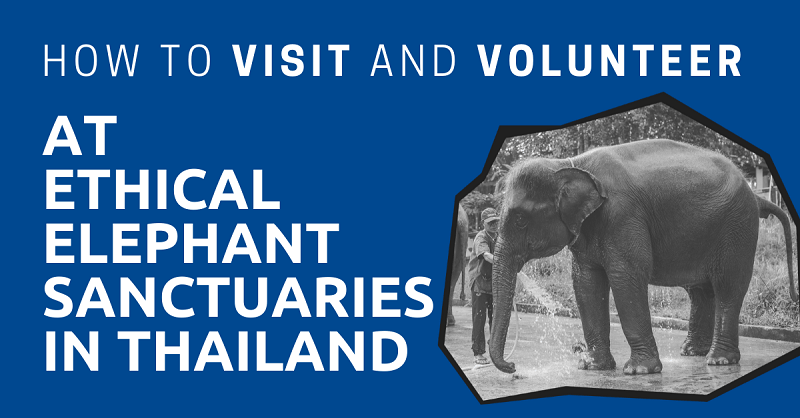
In the last two decades nature based tourism has become popular in Thailand.
Increasing awareness of the plight of forests and wildlife and increased demand from tourists for nature-based travel has resulted in scores of companies offering package tours and individually designed itineraries that focus on getting close to nature and wildlife.
Elephants have been a part of this movement. It’s possible to go jungle trekking with elephants, visit national parks with wild elephants, or see them in open zoos.
In this post I’m going to cover some of the ethical sanctuaries in Thailand where you can see elephants in captivity or in the wild.
"*" indicates required fields
Disclaimer: This article may include links to products or services offered by ExpatDen’s partners, which give us commissions when you click on them. Although this may influence how they appear in the text, we only recommend solutions that we would use in your situation. Read more in our Advertising Disclosure.
Contents
- Why Visit an Elephant Sanctuary?
- What is an Elephant Sanctuary?
- General Rules
- Preparing for Your Trip
- Visiting Ethical Sanctuaries
- Visiting Elephants in the Wild
- Volunteering at a Sanctuary
Why Visit an Elephant Sanctuary?
Elephants are an important part of Asian forest ecosystems, serving as natural forest gardeners, keeping the understory open and moving seeds around in the forest.
Elephants are also an important part of Thai culture and have been so for hundreds of years.
Captive elephants carried former Thai kings into war with the Burmese, and after the Forestry Department was founded in 1896, trained elephants helped the government log native forests for timber for one hundred years.
After commercial logging was banned in 1989, some 3,000 elephants became jobless, precipitating a welfare crisis for elephants and mahouts.
Fortunately many out of work elephants and their descendants are now cared for at camps where they receive food and healthcare and do not have to walk the streets begging for food or hauling logs.
There are 3,000 to 3,700 wild elephants and 3,500 to 4,000 captive elephants in Thailand.
The numbers are probably declining slowly as poaching, conflict with farmers and habitat loss lead to elephant deaths each year.
It’s possible to pay to visit and meet these elephants at sanctuaries in Thailand.
What is an Elephant Sanctuary?
An elephant sanctuary is where elephants can roam free within a confined, protected space with minimal contact with humans.
A lot of places in Thailand claim to be elephant sanctuaries, but real sanctuaries must:
- be in a natural habitat
- have adequate space for roaming elephants
- provide at least 250 kilos of food per day, per elephant
- offer healthcare to elephants and mahouts
- give shelter to elephants and mahouts
- pair compatible elephants together
Real elephant sanctuaries are registered with the Ministry of Tourism and Sports and have conservation and welfare initiatives for their elephants.
Ideally, the camp will have a foundation or charity that supports elephant welfare or wildlife conservation.
Part of your ticket money should go to helping mistreated or injured elephants, or to preserving habitat for wild elephants.
Some sanctuaries may also look after trafficked or mistreated elephants.
Elephant camps that don’t have all or some of these characteristics are not likely going to be good places to visit.
Some camps that try to pass off as sanctuaries rent or buy elephants, even if they say they “rescued” them from bad situations, so be cautious.
General Rules
Before you visit an elephant sanctuary in Thailand there are a few general rules you should keep in mind. These rules aren’t in place to restrict your experience, but to protect the well-being of the elephants.
Listen to Mahouts
Ask before approaching an elephant and follow the instructions of the mahout or handler. Even elephants comfortable with humans may behave erratically depending on their mood.
Male elephants periodically enter musth, a condition when their testosterone levels skyrocket and they become aggressive and can cause injury to humans around them.
Act Accordingly
Respect the elephants. When approaching an elephant don’t make sudden movements or raise your voice. Approach them slowly from the front or side where they can see you.
If you surprise them from behind or approach them too quickly you might frighten them and they may react unpredictably.
Don’t Feed Elephants
Don’t feed the elephants unless you have permission and only feed them with food the handler gives you. They may be on strict diets.
Preparing for Your Trip
Before you set off our your elephant excursion there are a few things you’ll need to pack. These things will make your trip more comfortable and memorable.
- bathing suit
- change of clothes
- durable camera*
- hat
- light clothes to keep cool
- mosquito repellent
- sunscreen
- walking shoes or sneakers
- water
*Elephants can sometimes be sensitive to flash photography but the response may be different between animals, so check with the mahout to see if flash is okay to use.
Visiting Ethical Sanctuaries
Below are four choices for visiting elephants sanctuaries in Thailand. They aren’t the only elephant sanctuaries in Thailand, but they are some of the more popular ones.
- Anantara Golden Triangle Elephant Camp and Resort
- Wildlife Friends Foundation Thailand
- Chiang Mai Elephant Jungle Sanctuary
- Elephant Hills
Anantara Golden Triangle Elephant Camp and Resort (Chiang Rai)
Anatara Golden Triangle Elephant Camp and Resort is run by a long-term expat John Roberts. The sanctuary is at the Anantara Resort at Chiang Saen District in Chiang Rai Province.
This is as close as you’ll get to a true elephant sanctuary. There are roughly twenty to twenty-five elephants, their mahouts, and families living at the camp on a sprawling property with plenty of natural scrub and bamboo in an idyllic setting by the Mekong River.
Some of the elephants and their mahouts come from difficult situations on the streets of Bangkok.
Activities
You can walk along forest trails with elephants, bathe with them, or volunteer to join a research team who study the elephants behavior.
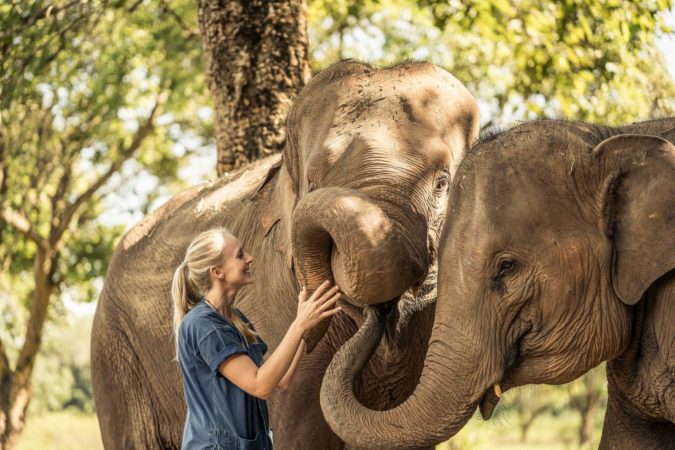
How to Get There
The Anantara Resort is a one-and-a-half-hour drive through the lush countryside of rice fields, wetlands, and rolling hills of Chiang Rai from Chiang Rai Airport, or a four-and-a-half-hour drive from Chiang Mai.
| Location | Taxi One Way | Rental Car |
|---|---|---|
| Chiang Rai Airport | 600 baht | 1,200 baht per day |
| Chiang Mai Airport | – | 1,200 baht per day |
Address:
- Anantara Golden Triangle Elephant Camp and Resort, 229 Moo 1, Chiang Saen, Chiang Rai 57150
- Anantara Golden Triangle Elephant Camp and Resort 229 Moo 1 ตำบล เวียง อำเภอ เชียงแสน เชียงราย 57150
Contact:
- +66–53 784 084 (English, Chinese, and Thai)
- [email protected]
Entry
This is a private camp only available to guests of the Anantara Golden Triangle Resort or by special appointment. You can book a room with Anantara here.
Wildlife Friends Foundation Thailand (Petchaburi)
Wildlife Friends Foundation Thailand, or WFFT, is part of a rescue center set up to take in injured and trafficked animals.
It’s run by Edwin Wiek, who has worked in conservation and animal welfare in Thailand for more than thirty years.
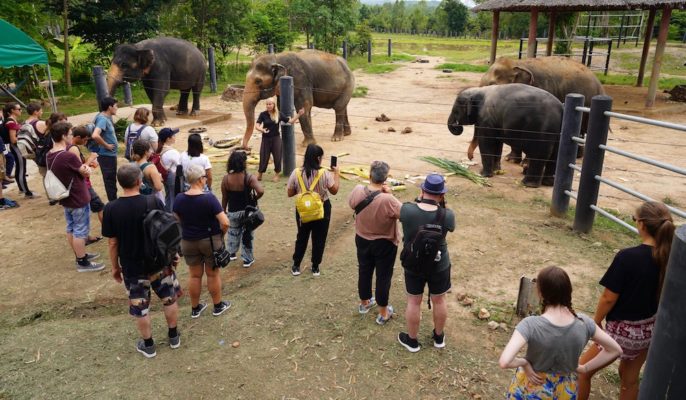
Originally built on land owned by a local temple in Tha Yang District, Petchburi Province, WFFT has expanded in recent years.
There are around ten elephants at WFFT. No elephants are chained and they have plenty of space to roam.
Activities
It’s possible to volunteer at WFFT. They are especially interested in having skilled animal specialists such as vets and animal handlers but motivated volunteers with no specific experience working with animals are also welcome.
The centre runs a half-day tour and a full-day tour most days of the year.
The tours are run by experienced staff and you’ll get to see around the property and learn about the animals, why they are there, and how they are cared for.
You’ll get to see not just elephants but bears, macaques, gibbons, orangutans (yes they have a pair there that were rescued from an unscrupulous owner), and many others.
You can stay in an eco-lodge where you can see the elephants from the verandah for 4,000 baht a night
How to Get There
WFFT is in Petchaburi, just forty minutes from Hua Hin. You can drive or take a taxi to the sanctuary but you’ll need to get there before 10:00 AM.
You could also schedule WFFT to pick you up and drop you off. Here are some of their prices for nearby locations.
| Location | One Way | Return |
|---|---|---|
| Hua Hin | 200 baht | 200 baht |
| Cha Am | 200 baht | 200 baht |
| Pranburi | contact for price | contact for price |
| Bangkok | 2,200 baht | 3,500 baht |
Address:
- Wildlife Friends Foundation Thailand, 108 Moo 6, Tha Mai Ruak, Phetchaburi 76130
- Wildlife Friends Foundation Thailand 108 Moo 6 ตำบล ท่าไม้รวก เพชรบุรี 76130
Contact:
- +66–32–458135 (Thai)
- +66–82–2458598 (English)
- Skype: wildlife_rescue
Entry
WFFT is open everyday from 8:00 AM to 5:00 PM. But they limit the number of visitors each day so you should book ahead of time. Fill in the booking form on their website to reserve a spot.
| Entry Fees | Half-day Tour | Full-day Tour |
|---|---|---|
| Adults | 1,100 baht | 1,600 baht |
| Children 6 – 12 | 900 baht | 1,100 baht |
| Children < 6 | free | free |
Prices to volunteer with elephants are below. WFFT values commitment so if you want to stay longer it gets cheaper.
| Volunteer Period | Prices |
|---|---|
| 1 Week | 16,000 baht |
| 2 Weeks | 25,000 baht |
| 3 Weeks | 30,000 baht |
| 4 Weeks | 42,700 baht |
| Additional Weeks | 8,850 baht |
Chiang Mai Elephant Jungle Sanctuary (Chiang Mai)
Chiang Mai Elephant Jungle Sanctuary, or EJS, offers ethical elephant adventures where you can learn about elephants, or walk, bathe, or play with the animals.
Activities
You can go on treks with the elephants and their mahouts, and visit the Thai and hill-tribe communities where captive elephants spend their time.
You can visit the EJS Elephant Care Project and see the Elephant Clinic, or learn about the Mahout Training Program and the rescue program for older elephants.
Full-day or overnight jungle treks with elephants are available.
How to Get There
EJS is a one-and-a-half hour drive from Chiang Mai town.
| Location | EJS Pick Up | Taxi One Way |
|---|---|---|
| From Chiang Mai | Free | 200 baht |
Address:
- Chiang Mai Elephant Jungle Sanctuary, 119/10 Tha Phae Rd, Tambol Changklan, Amphoe Mueang Chiang Mai, Chang Wat Chiang Mai 50100
- Chiang Mai Elephant Jungle Sanctuary 119/10 ตำบล ช้างคลาน อำเภอเมืองเชียงใหม่ เชียงใหม่ 50100
Contact:
- 053–273–4215
- [email protected]
Entry
Elephant Jungle Sanctuary is open everyday from 8:00 AM to 5:00 PM.
| Activity | Adults | Children |
|---|---|---|
| Full Day Trekking | 3,500 baht | 2,900 baht |
| 6:30 AM to 12:30 PM | 1,700 baht | 1,300 baht |
| 1:30 PM to 6:30 PM | 1,700 baht | 1,300 baht |
| 2-Day Overnight Jungle Trek | 4,900 baht | – |
Elephant Hills (Surat Thani)
Elephant Hills is in Phanom District, Surat Thani, near Khao Sok National Park. This camp is nestled in the foothills under towering karst mountain peaks.
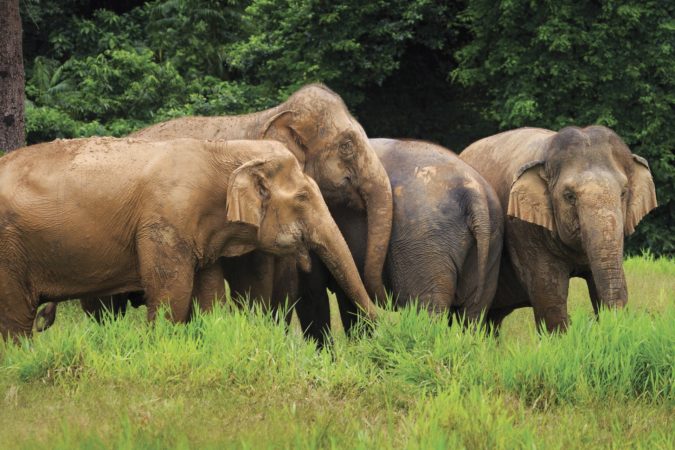
Activities
Take a two- or four-day jungle safari that includes spending time with elephants and visiting the Chiew Larn Lake, formed by the Rajaprabha Dam.
Stay in a luxury tent in the forest or floating on the lake.
How to Get There
You can get to Elephant Hills by a two-hour car drive from from Phuket Airport, or a three-hour car drive from Phuket Town. Surat Thani, another nearby location, is only a two-hour drive from Elephant Hills.
Address:
- Elephant Hills, Khlong Sok, Phanom District, Surat Thani 84250
- Elephant Hills ตำบล คลองศก อำเภอ พนม สุราษฎร์ธานี 84250
Contact:
- +66 5200 1186
- +66 5200 1196
- [email protected]
Entry
This is a private sanctuary for guests of the Elephant Hills, which offers special tours.
| Activity | All-inclusive Prices |
|---|---|
| Jungle Safari – 2 Days/1 Night | From 12,580 baht |
| Jungle Safari – 3 Days/2 Nights | From 18,572 baht |
| Jungle Lake Safari – 3 Days/2 Nights | From 12,372 baht |
| Rainforest Nature Safari – 4 Days/3 Nights | From 23,368 baht |
Visiting Elephants in the Wild
If you’d rather see elephants in the wild instead of at sanctuaries you can go to a national park such as:
- Kui Buri National Park
- Kaeng Krachan National Park
- Khao Yai National Park
All three national parks are just a few hours drive from Bangkok and each of them have tour guides you can hire to take you around by foot or by vehicle.
Kui Buri National Park
Kui Buri National Park is in the evergreen forests of Tenasserim Hills of Prachuap Kiri Khan.
The national park is home to some 320 elephants. And visitors are sure to see wild elephants roaming freely every day.
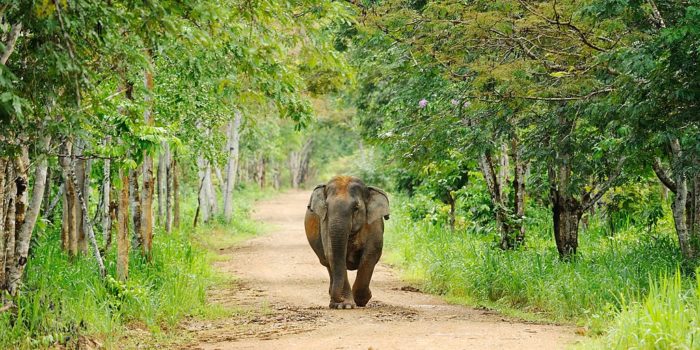
Activities
You can take a guided tour in a safari vehicle, camp out under the stars, or rent one of the three-bedroom bungalows.
| Activity | Prices |
|---|---|
| Guided Safari Tour | 850 baht |
| Rent a Tent | 270 baht per night |
| Bring Your Tent | 30 baht per night |
| Bungalow | 1,800 baht per night |
How to Get There
The easiest way to get to Kui Buri National Park is to first get to Hua Hin. From Hua Hin, you can take a take to the park for 1,400 baht one way, or 2,200 baht round trip.
Entry
Kui Buri National Park is open from 2:30 PM to 6:30 PM but you can’t enter the park after 5:00 PM.
| Entry Fees | Prices |
|---|---|
| Thai Children | 20 baht |
| Thai Adults | 40 baht |
| Non-Thai Children | 100 baht |
| Non-Thai Adults | 200 baht |
Address:
- Kui Buri National Park, Hat Kham, Kui Buri District, Prachuap Khiri Khan 77150
- Kui Buri National Park ตำบล หาดขาม อำเภอ กุยบุรี ประจวบคีรีขันธ์ 77150
Kaeng Krachan National Park
Kaeng Krachan spans 2,914 kilometers of Thailand’s central region. It is the largest national park in Thailand where elephants are free to roam through the lush jungles.
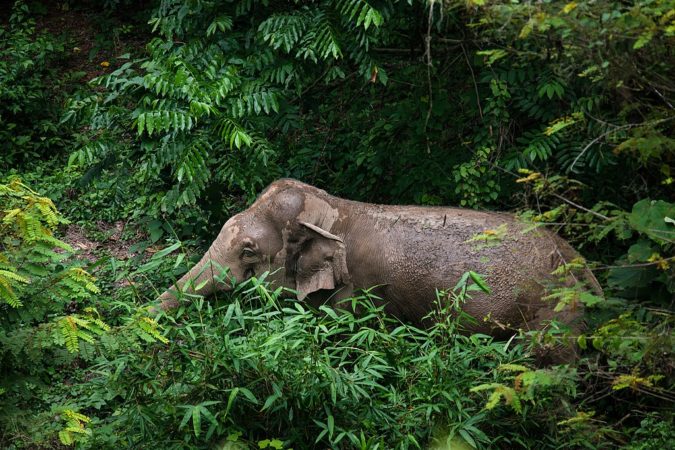
Activities
The only way you’re going to see elephants at Kaeng Krachan is by trekking through the winding trails of the national park.
But the trails are not for the faint of heart. So you should hire a trail guide to help you navigate the area.
| Activity | Price |
|---|---|
| 3-hour Trail Walk with Ranger | 400 baht |
| 4-hour Trail Walk with Ranger | 500 baht |
| Bring Your Tent | 30 baht per night |
| Bungalow | 1,800 baht |
How to Get There
You can get to Kaeng Krachan National Park by taxi from either Hua Hin or Bangkok or the surrounding areas.
| Location | Price |
|---|---|
| Hua Hin | 1,400 baht to 2,800 baht |
| Bangkok | 2,400 baht to 3,800 baht |
Address:
- Kaeng Krachan National Park, Kaeng Krachan, Kaeng Krachan District, Phetchaburi 76170
- Kaeng Krachan National Park ตำบล แก่งกระจาน อำเภอ แก่งกระจาน เพชรบุรี 76170
Entry
Kaeng Krachan National Park is open from 5:00 AM to 7:00 PM at the main entrance of the national park. Opening times at other entrances vary.
| Entry | Price |
|---|---|
| Thai Children | 40 baht |
| Thai Adults | 100 baht |
| Non-Thai Children | 200 baht |
| Non-Thai Adults | 300 baht |
Khao Yai National Park
Khao Yai was Thailand’s first national park and is home to many wild elephants. Although you might have a better chance at seeing wild elephants in Kui Buri or Kaeng Krachan, the destination is still a marvel of nature.

Activities
If you want to see a wild elephant at Khao Yai, you’re best bet is to take a group tour as guides know where the elephants usually hang around.
| Activity | Price |
|---|---|
| 1-Day Night Safari Tour | Based on group size |
| 2-Day Wildlife Tour | Based on group size |
| 3-Day Wildlife Tour | Based on group size |
How to Get There
Khao Yai National Park is only a few hours drive from Bangkok. You can take a taxi there, rent a car, or drive your own car. You can take your car into the park.
| Location | Price |
|---|---|
| From Bangkok | 2,300 baht to 3,800 baht |
| From Pattaya | 3,400 baht |
Address:
- Khao Yai National Park, Hin Tung, Mueang Nakhon Nayok District, Nakhon Nayok 26000
- Khao Yai National Park ตำบล หินตั้ง อำเภอเมืองนครนายก นครนายก 26000
Entry
Khao Yai National Park is open everyday from 6:00 AM to 6:00 PM.
| Entry | Fee |
|---|---|
| Children | 200 baht |
| Adults | 400 baht |
Volunteering at a Sanctuary
At some camps it’s possible to volunteer your time to help feed or take care of elephants or help with exercising elephants. If you want to volunteer contact the camp directly by phone or email.
WFFT is set up for volunteers so they might be one of your first points of contact. You can contact them about volunteering here.
To volunteer to help elephants you need to:
- be in good health
- tolerate a hot and humid climate
- speak English
- be 18 years old or older
- have a positive and practical attitude towards animal welfare and wildlife conservation
If you plan to stay a few days or weeks you don’t need a volunteer visa. But for longer stays you might want to get a volunteer visa. Ask the sanctuary you’ll be volunteering with if they can help you get the volunteer visa.









